Ferns are some of the oldest plants on earth. Fossil records even date ferns back hundreds of millions of years before the Jurassic period.
The years of evolving species of fern have made them suitable for just about every type of environment and weather condition.
At the moment, scientists have discovered and documented over 10,000 individual kinds of ferns…
With many more still thought to exist.
With that being said, there is an abundant variety of ferns to choose from that would be more than fitting as a vivarium plant.
This article will aid in helping you choose the right ferns for your enclosure.
What Are Ferns?
Ferns are vascular plants that reproduce by spore propagation and don’t produce seeds or flowers.
They are very closely related to mosses in the way they reproduce and are actually classified under the same embryophytes category.
There is generally a defining difference between the two categories of plants…
Moss is nonvascular and ferns actually have true leaves called megaphylls.
Ferns are also commonly referred to as Monilophytes, Polypodiophyta, and Pteridophytes in the scientific community.
Something to keep in mind, Pteridophyte is a term many experts don’t recognize ferns specifically as anymore.
Pteridophytes are vascular plants that reproduce through spores.
So technically, Lycophytes could fall under that same classification as well.
Furthermore, Polypodiophyta only represents one of four groups in total that make up the entire class of ferns…
But since this class of fern makes up the majority of the fern families, the term is commonly used to generalize ferns as a whole.
Even though specific species of ferns thrive in a variety of climates, a good majority of ferns recommended today do best in moist, shaded locations like tropical environments.
Furthermore, these types of sporophytes can range in size and shape…
This article will focus primarily on a number of smaller species that should be considered when stocking various types of vivariums.
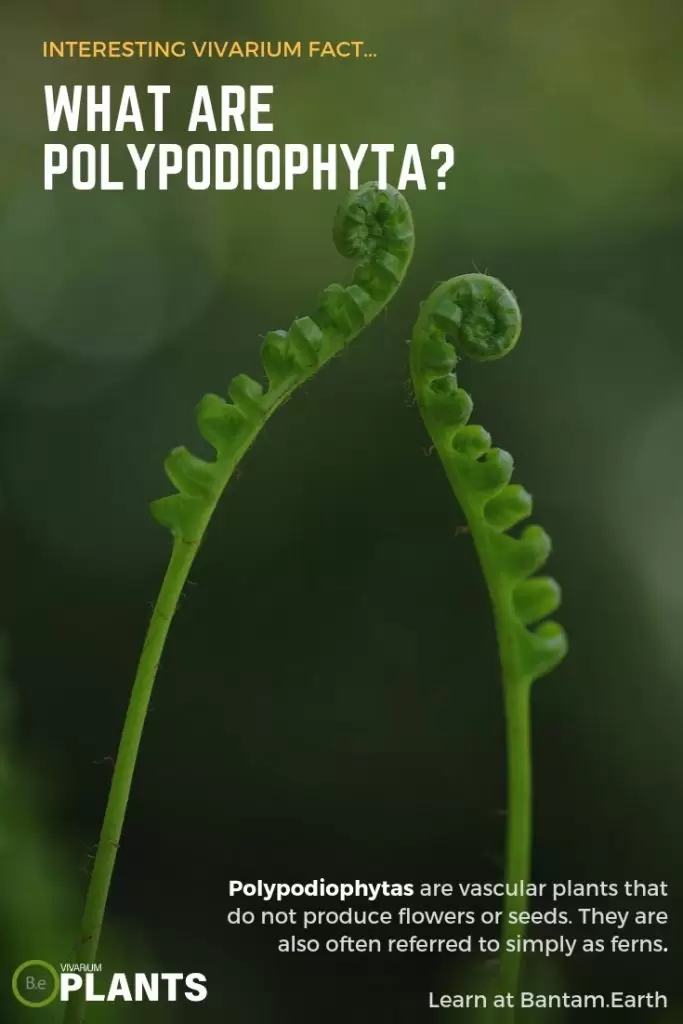

Miniature Ferns
Miniature ferns are a variety of polypodiophyta that do not grow larger than a foot or two in height as well as width.
This list today will cover ferns that are great for vivariums due to their dwarfing nature and fitting environmental needs that vivariums easily provide.
Currently, the vivarium market offers most of these types of plants for use in closed enclosures as well as decoration within households.
When shopping for miniature ferns, it would be ideal to first have a proper understanding of what it takes to care for these types of plants as well as the conditions these plants are being sold in.
Pteridophytes we list here all generally like the same moist, high humidity type of environment…
With the exception of fully or partially aquatic ferns that will require a large body of water to reside.
The growth pattern, rooting system, and propagation process are also very similar to one another.
I will explain a little further to get a better idea of what I mean.
The Growth Pattern
The growth pattern of ferns can range in a number of ways I think is important to understand when deciding on a choice for a particular type of vivarium.
Some can grow underwater, while others can grow between rocks completely free from the substrate.
Many species make excellent ground covers… While others emerge in clumps providing a canopy-like appearance to smaller plants.
Keeping these features in mind will aid in not only the longevity of the ferns…
But also create a consistent flow within the enclosure that will aesthetically make sense as the tank establishes.
Here is a list of ways different types of ferns have the ability to grow:
- Submerged – Have the ability to grow fully underwater, either rooted to substrate or tied to wood and rocks.
- Emerged – Have the ability to grow marginally or somewhat out of water. The base of the fern is fully placed underwater while parts of the frond come above water.
- Floating – Have the ability to float on top of standing water. These ferns have small hairs that cover the fronds allowing them to stay above water while roots are left draped down.
- Epiphytes – Have the ability to be grown above ground. In most cases, the fern will latch onto rocks, trees, or other acidic surfaces where it absorbs nutrients from fallen water and/or moist air.
- Oxylophytes – Have the ability to be grown in acidic soils. These types of ferns require a damp substrate in order to obtain needed nutrients.
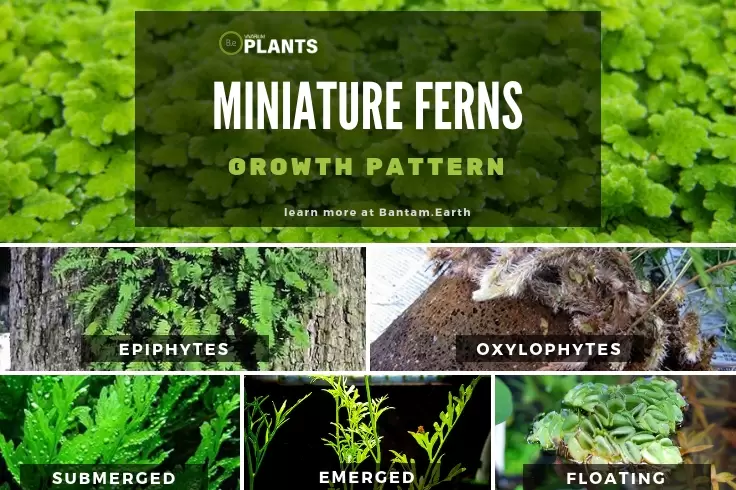

The Root System
The root system of a polypodiophyta is another essential part of the plant all should have a basic understanding.
All ferns have some type of rooting structure that is located on the lower end of the plant.
Depending on the particular species of fern, The function of the root and the way it looks will vary.
The plants under half will either consist of rhizomes, a central root ball, or a root-like structure that lacks a lot of the traditional function roots generally have.
Rhizomes
Rhizomes are a system of stems that grow underground or in some cases, slightly above the substrate.
These types of roots absorb needed nutrients through water scavaged from the surrounding soil.
The interesting takeaway from ferns that utilize the rhizome root system is that smaller stems will shoot from distant roots.
Giving the illusion that new plants are sprouting from surrounding areas.
Rootball
The root ball system is pretty self-explanatory.
The mass clump of stems that make up this root structure is typically found in ferns that grow in a more bush or tree format.
The good thing about these types of plants is they do not require a wide amount of underground soil space.
Annual repotting is usually all that is needed to keep these perennial plants going for years to come.
Root-like Structure
The last type of root structure is a very interesting one.
Most aquatic ferns utilize a root-like system that doesn’t play the same role as the prior two kinds of roots.
Floating ferns, for instance, have long hair-like roots that simply drape down into the water.
These ferns typically benefit more from the nutrients absorbed through moist air.
Other non-aquatic ferns that have similar types of root systems are epiphytic ferns.
These ferns are typically found growing without soil…
Latched onto rock or tree surfaces or between stones along the edge of cliffs.
The Propagation Process
The growth process is generally the same for polypodiophyta as a group.
Naturally, ferns reproduce through the process of sporulation.
This is a very slow process and very hard to influence within the typical vivarium.
A more common practice used by hobbyists today is division.
Depending on the type of fern and the environment it is growing in…
Simply clipping small stems off parent plants or separating the root structure will be enough to warrant a new plant.
As you navigate through the list of miniature ferns, take a closer look at the article about a particular fern to learn more about the best propagation process.


Types Of Miniature Ferns
Now that there is a general understanding of polypodiophyta, we can cover the best types of mini ferns for controlled environments.
The ideal types of miniature ferns can be either aquatic, terrestrial or a combination of both (marginal).
With that in mind, a hobbyist has a vast amount of options when it comes to stocking an enclosure with ferns.
Terrarium Fern Types
Terrarium ferns are the terrestrial version of the plant that thrives on land away from flowing water.
For the most part, ferns like moist, humid environments but not overly saturated soils.
Moderate airflow, as well as proper drainage, will be a necessity for terrarium-dependent ferns.
Upper areas of paludariums will also be great environments for these kinds of polypodiophyta.
Below is a complete list of vivarium ferns to consider:
Rabbit Foot Fern (Davallia tyermanii)
Davallia tyermanii has one of the most interesting root structures of all the ferns covered in this guide.
The rhizomes this plant produces are thick and hairy closely resembling a hare’s foot…
Hint’s the common name. The Rabbits Foot Fern is not a common plant to stock in a closed vivarium.
Nonetheless, its environmental requirements make it a very fitting prospect for a large tropical terrarium.
With high humidity levels and proper substrate, this plant will thrive fairly easily and grow to a height of 12 to 24 inches tall.
This type of polypodiophyta is best used as a background plant to fill in large open areas.
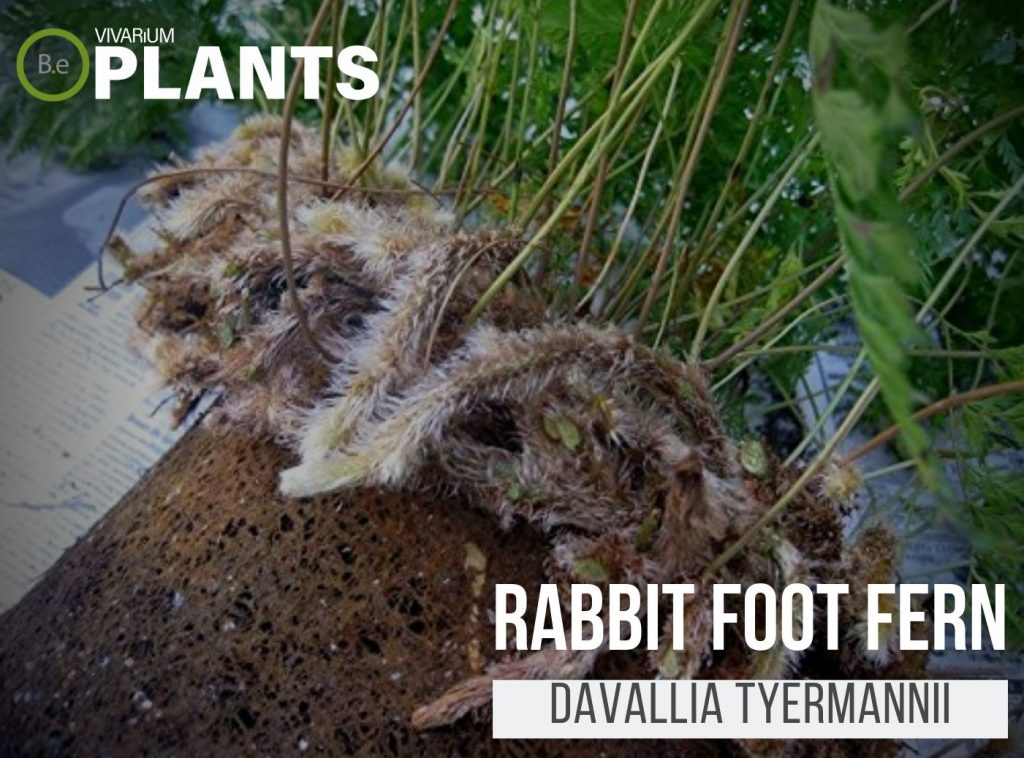

The type of habitat Rabbits Foot Fern is commonly found in is tropical and damp.
It can be spotted growing on moss-covered rocks and trees in shaded areas.
The lighting should be moderately bright and out of reach from direct sunlight.
This is not a plant I’d recommend for beginner hobbyists…
But with a little patience and understanding, this flora will grow and sprout new stems in surrounding areas!
Bird’s Nest Fern (Asplenium nidus)
Asplenium nidus, also known as Bird’s Nest Fern, is an interesting and unique-looking houseplant that can also be grown in a terrarium.
As one of the few true epiphyte ferns to prominent feature in hobbyist enclosures, the wavy and soft ruffled fronds are perfect for adding texture and a tropical feel to your tank.
Although this plant is relatively easy to manage, it can be quite tricky in a humid, temperate vivarium.
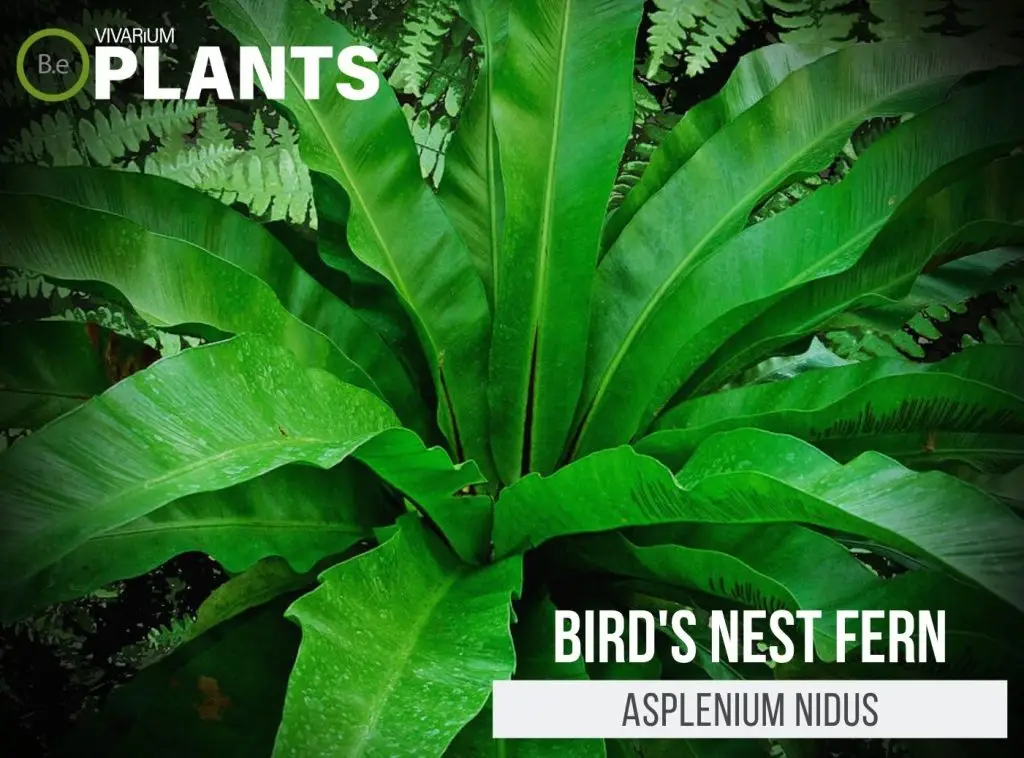

Asplenium nidus is a species of fern that grows in a compact and curved shape.
It has knobby plantlets that form on older, mature fronds and can eventually spread across the plant.
Its leaves are broad and thin, with fronds reaching around 18 inches in length.
Its namesake comes from the bird’s nest-like shape of the ruffled leaves, sometimes with brown edges.
The Bird’s Nest Fern is a unique tropical plant native to New Guinea, Malaysia, India, and other southeast Asian countries.
Silver Lace Fern (Pteris ensiformis)
Pteris ensiformis is one of many tiny ferns great for vivarium keeping.
Closely resembling other Pteris species, ferns on this list, Silver Lace Fern can sometimes be confused and misidentified.
The pinnate fronds this flora produces are vivid in color and are capable of really adding life to an enclosure.
This plant is relatively simple to care for and will grow to be as tall as 12 to 16 inches tall.
It will require soil solid enough to hold the plant in a firm upright position and kept damp at all times.
Being striking oriental foliage, this Silver Lace Fern will do anywhere within the terrain area.


Subtropical to fully tropical environments are what make up the habitat this fern does best in so keep it in mind when constructing.
This is a shade-happy plant so avoid direct sunlight and provide brightly lit surroundings.
Pteris ensiformis, for the most part, is a very hardy plant I would recommend to beginner-level enthusiasts.
Crocodile Fern (Microsorum musifolium ‘crocodyllus’)
Microsorum musifolium ‘crocodyllus’ is a very interesting plant to cover.
The scaling pattern the leaves of this fern exhibits make it rather exotic and distinguishable from any other polypodiophyta.
Something to note, crocodile fern can grow rather large over time, reaching heights up to five feet tall.
Therefore making it is not exactly a miniature fern if left unattended long enough.
I personally love the concept of making a large room-size terrarium at some point in the near future…
And using this fern to exaggerate a sort of Jurassic-type theme.
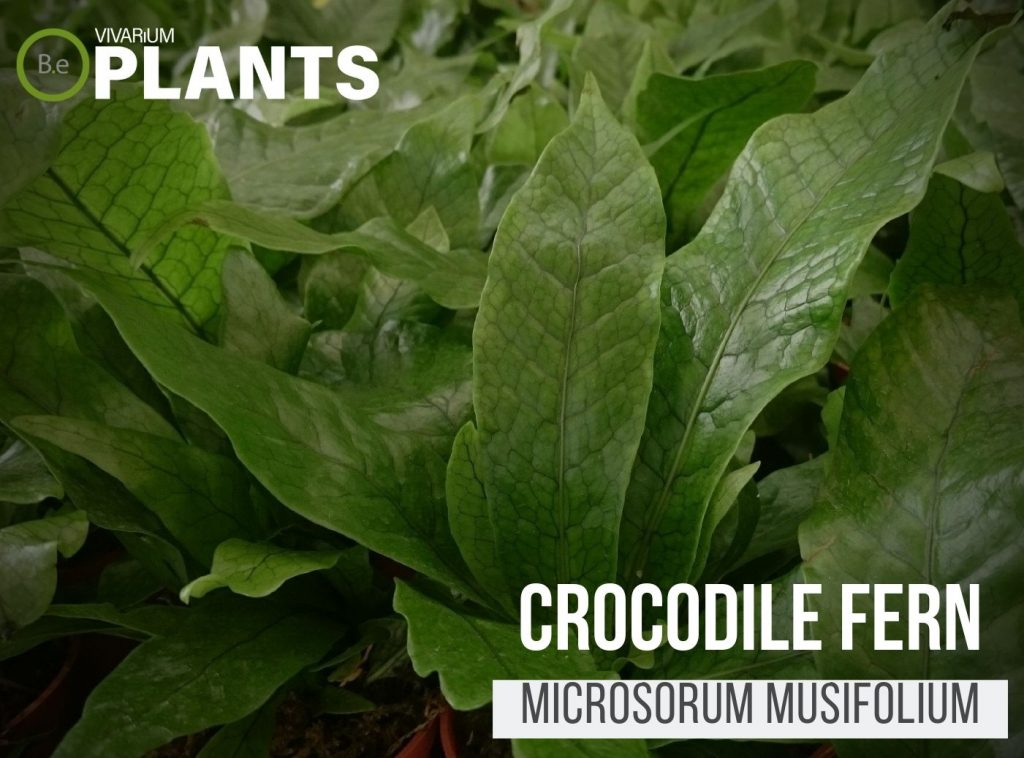

The care requirements for crocodile ferns are going to be similar to other tropical ferns.
It can be grown epiphytically on backgrounds or buried in loose acidic soil.
Even though this fern showcases a strong, tusk-like appearance…
It can still be sensitive to direct sun exposure and should be kept in shade the majority of the time.
Furthermore, avoid placing Microsorum Musifolium too close to aquatic areas as well.
This is a terrain base fern that requires a moist, humid environment.
Staghorn Fern (Platycerium spp.)
Platycerium spp. (Staghorn ferns) is an epiphytic vivarium plant ideal for any enclosure with or without animals.
Staghorn ferns are easy to care for and are best known for their unique shape, resembling the horns of a stag.
Growing as a clump, Staghorn ferns tend to resemble a deep-sea creature such as a manta ray.
Because of their hearty nature, Staghorn ferns are a great low-maintenance terrarium plant.
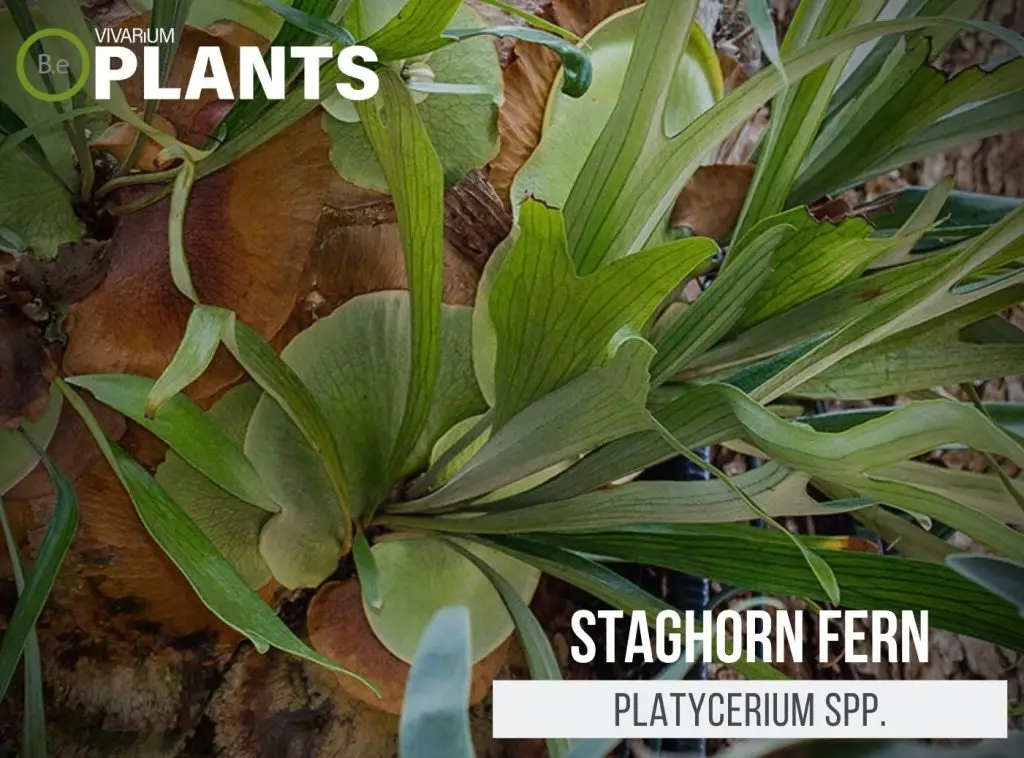

Staghorn ferns form as a clump or as a single-stalked fern.
The first leaves, or fronds, form a shield protecting the plant against strong winds and direct sunlight.
Its overlapping horn-like leaves grow in a circular shape, the outer fronds resembling a shield, five to six inches tall.
The center of the plant has a deep root system, providing moisture, food, and stability.
It’s ideal to have these ferns on a piece of wood, as they do not thrive in soil.
Heart Fern (Hemionitis arifolia)
Hemionitis arifolia is typically used as a household plant but has proven over time to do far better in vivariums.
The constant need for high humidity and moderately warm temperatures have made this flora a challenge for many trying to maintain it successfully outside of a closed terrarium.
Heart Fern is another unique plant in appearance showcasing leaves that are… well… Shaped like hearts!
This fern easily falls in the miniature fern category reaching a maximum height of ten inches.


In the wild tropics, Heart Fern can be found growing along the forest floor or along the trunk of trees.
I would consider this a relatively good creeping plant to place in the foreground of an enclosure or background wall.
Aim for bright, artificial lighting or indirect sunlight for best results.
This type of fern may require some trial and error before figuring out its specific care needs…
Button Fern (Pellaea rotundifolia)
Pellaea rotundifolia is a great vining type fern for all-size terrariums.
Unlike many polypodiophyta featured on this list, Button Fern is more tolerable to dryer conditions.
The New Zealand forest this plant is native to is still generally high in humidity…
It’s just the soil preferences that are going to be less damp than typical ferns.
This plant can also be found growing on cliffs near coastal edges making it a great epiphyte to attach to rocky backgrounds.
I would highly suggest this plant for beginner enthusiasts looking to set up a woodland-type enclosure.


The caretaking needs of a Button Fern are relatively minimal.
All that is needed is a sufficient amount of acidic water and bright lighting.
Many hobbyists will grow this fern easily indoors so that should say a lot about how well it does with artificial lighting.
Pellaea rotundifolia has a signature coin-shaped appearance to its leaves… Many misidentify with lemon button ferns.
But the distinctive dark stems are usually an easy way to tell this fern apart from others.
Silver Ribbon Fern (Pteris cretica)
Pteris cretica is another brake fern I felt needed to be added to this list.
Its appearance very closely resembles that of Silver Lace Fern (Pteris ensiformis).
The difference with this plant is it grows a little bigger and is more tolerable in dryer locations.
Utilizing this plant in a vivarium really adds maturity as well as variegation to the enclosure.
The palm tree looks like the fronds Silver Ribbon Fern gives off also adds an interesting aspect of scale to a terrarium as well.


The natural habitat of Silver Ribbon Fern is rocky woodlands or shaded forests.
An interesting takeaway with this plant is its vertical scaping preferences.
Pteris cretica actually prefers steep hills and stone walls to latch on.
Consider this fern for a vivarium that needs to make use of empty space on textured backdrops.
Delta Maidenhair Fern (Adiantum raddianum)
Over time we will cover many varieties of Maidenhair Fern.
After all, there are hundreds of individual species that make up the Adiantum as a whole.
The Delta Maidenhair Fern variation of the species seems like it was made for life in a terrarium.
Everything about this fern, like its size, requirements, and growth rate, literally screams vivarium!
The habitat this fern is native to is tropical and rainy…
Even though Adiantum raddianum will require a well-drained substrate…
It is still very suitable for acidic enclosures that have heavy use of foggers or misters.
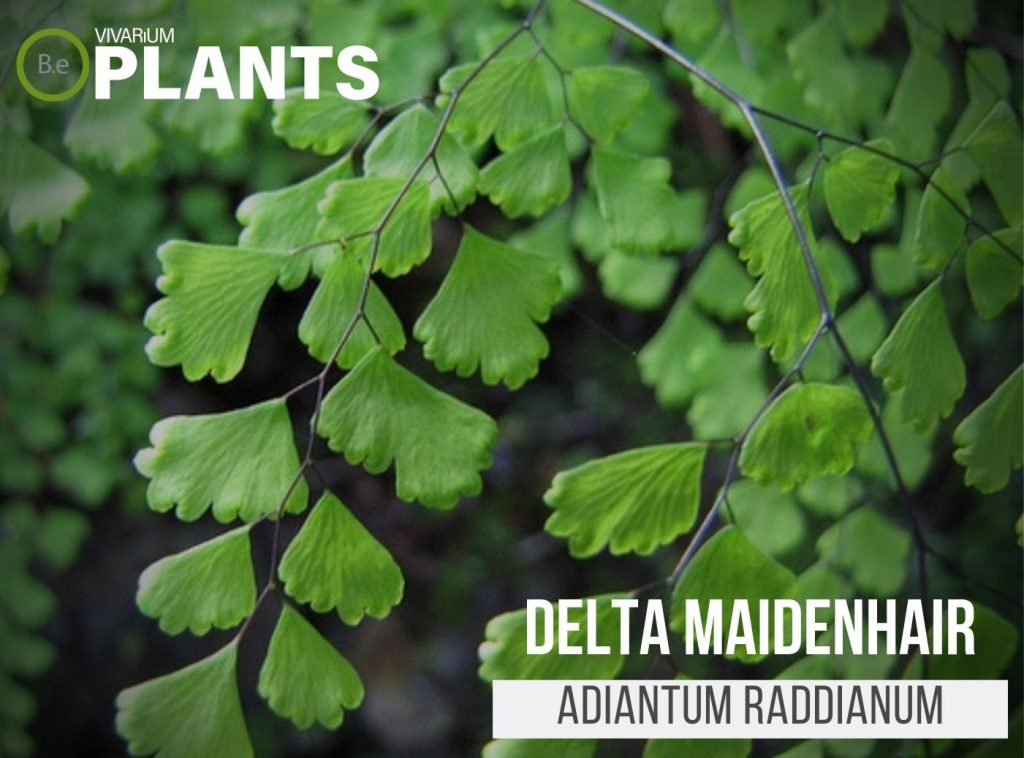

The care requirements for the Adiantum sp. are going to be generally the same…
Minus the fact that Delta maidenhair is more suitable to higher humidity than most other Adiantum sp. and has rather complicated lighting needs.
This plant will not do well in direct sunlight for long periods of time but does seem to appreciate small amounts of it.
I would recommend experimenting with its placement before settling for a permanent location.
Boston Fern (Nephrolepis exaltata)
Nephrolepis exaltata may be the most common fern on this list to see as a household plant.
It can grow rather large if not kept in check and may not be suitable for small enclosures.
Nonetheless, the Boston fern is the staple representation that comes to mind when most think about what a fern is.
It is a relatively easy plant to care for and comes in a variety of unique variations.
Tiger Ferns, for example, is a variegated hybrid of this plant that has white stripes tapered throughout its frond due to certain levels of direct sunlight.
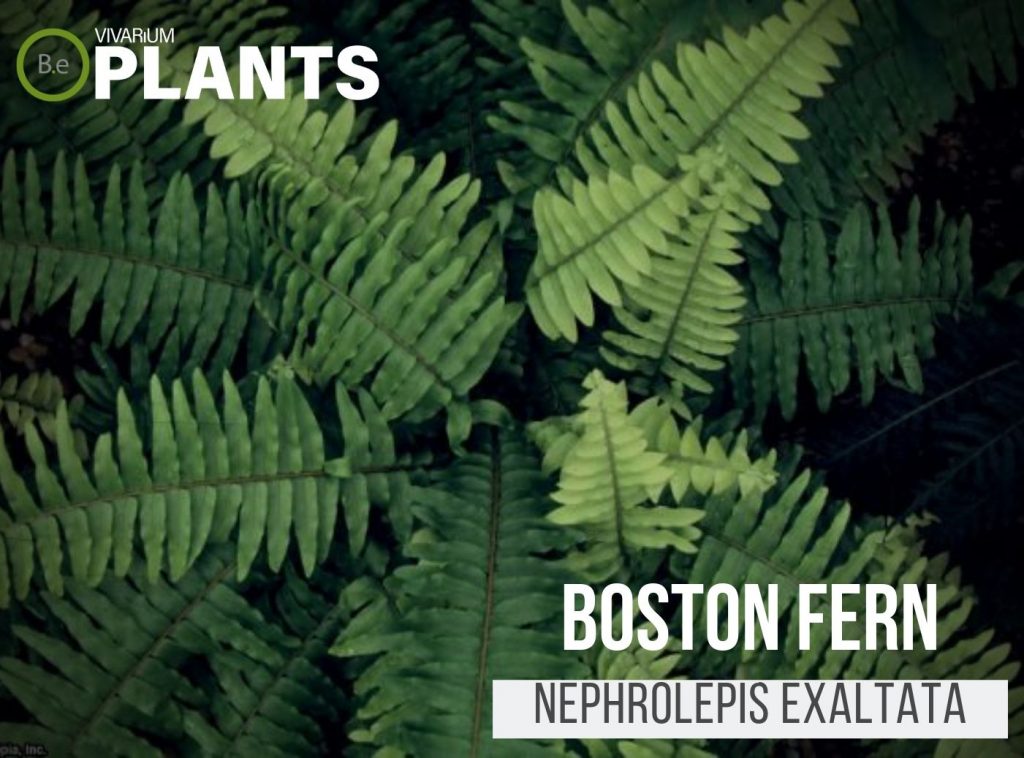

Boston Fern is a very forgiving plant when it comes to its care requirements.
I have personally seen this plant lose the majority of its fronds due to neglect and come back to life when small changes were made to its well-being.
I would highly recommend this plant to beginner-level hobbyists looking for a fern to experiment with.
Autumn Fern (Dryopteris erythrosora)
Dryopteris erythrosora is another rather exotic polypodiophyta on this list.
The bright fall-themed fronds this fern exhibits add the ultimate touch to an enclosure.
Surprisingly, Autumn Fern is not hard to care for.
The woodland environment it is native to is a damp, shaded location that is comprised of moderate humidity and bright lighting.
It will require a well-drained, acidic substrate as well for optimal growth.
This fern will reach a height of 18 to 24 inches if left untrimmed.
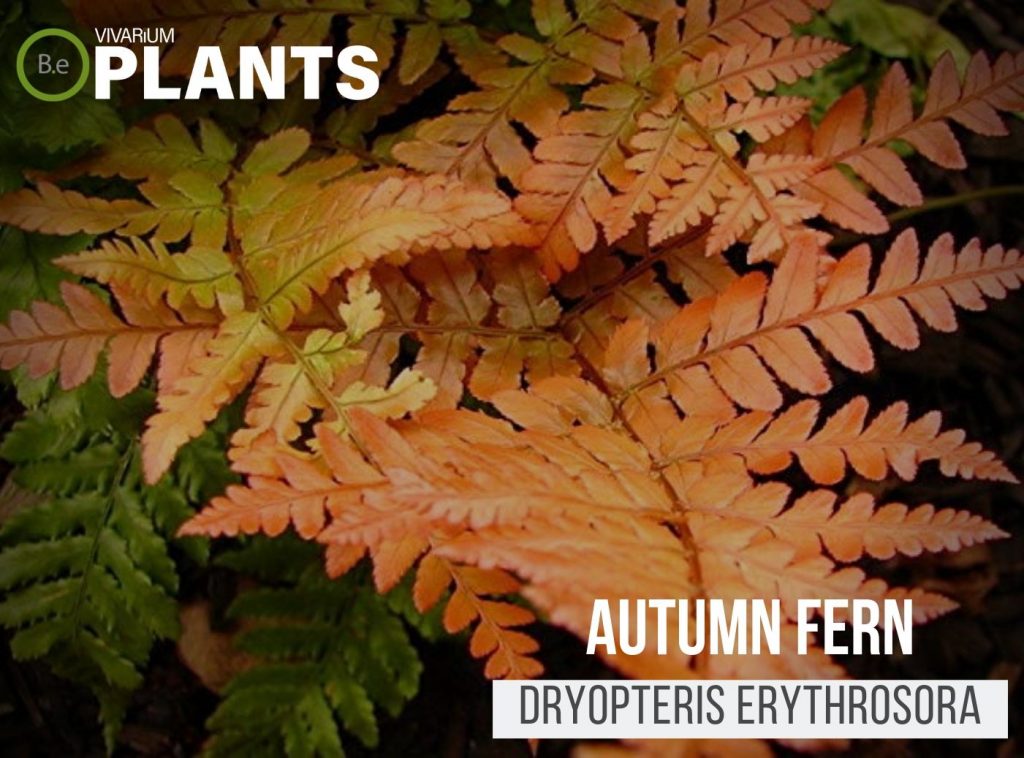

I would recommend splitting Autumn Fern into small parts and placing it in between other greener ferns closer to the background of the terrarium.
Once established, this type of flora is sure to give an enclosure a unique and natural look.
Lemon Button Fern (Nephrolepis cordifolia ‘duffii’)
Nephrolepis cordifolia ‘duffii’ is another common household plant owned by many hobbyists.
This species of fern is a very close relative to the Boston Fern.
In fact, upon closer inspection, one will easily realize its fronds resemble a stubby dwarfed version of the close cousin.
If a hobbyist was considering a Boston Fern for an inconveniently smaller tank, this flora would easily work as an alternative.
The Lemon Button Fern will reach a max height of 12 inches tall once established.
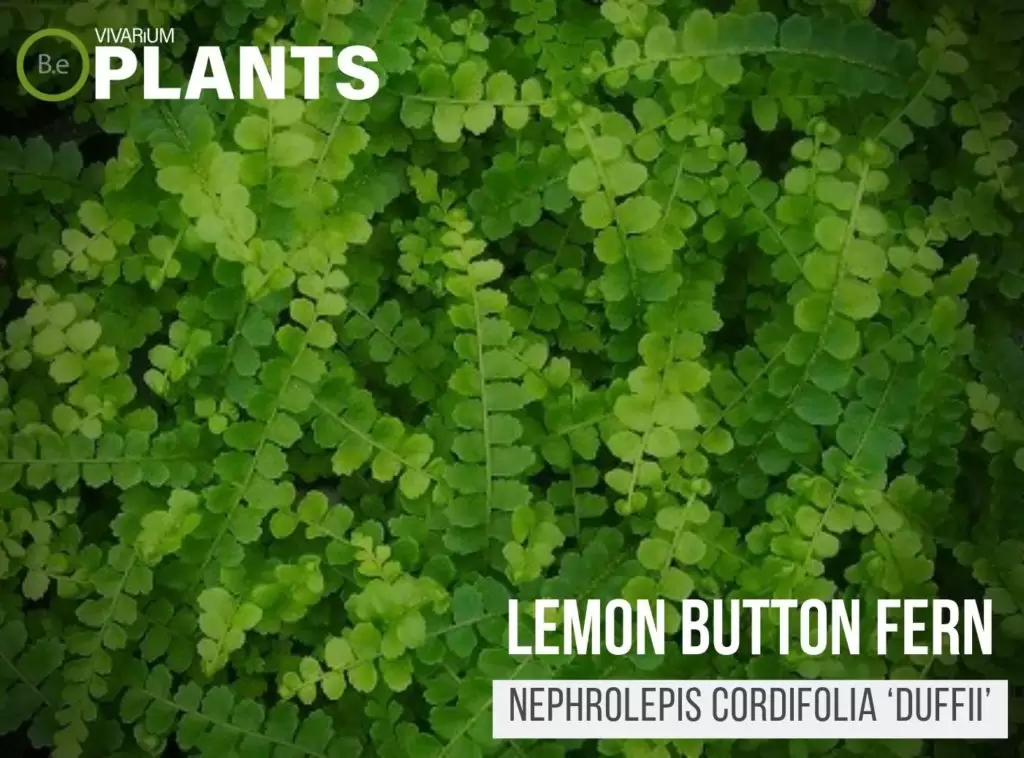

Lemon Button Fern is great for beginner enthusiasts due to its low caretaking needs.
The lighting should be bright and not direct sunlight.
The humidity should be moderately high and the substrate should be well-drained.
This fern is a pretty fast grower so trimming may be required to keep the aesthetics of the tank in check.
Aquarium Fern Types
Aquarium ferns are the aquatic version of the plant that thrives within the water feature section of vivariums.
The ideal location for this plant will predictably be fully submerged or partially immersed in flowing water.
Depending on the specific type of fern it is, it will either be fully submerged and anchored underwater or left free-floating on top of the water.
Also, keep a close consideration on if rather or not the water current should be high or low with each plant.
Below is a complete list of aquatic ferns to choose from:
Floating Fern (Salvinia natans)
Salvinia natans is a fully aquatic fern, which can appear superficially similar to floating moss.
If you are someone out in the market looking for a floating plant and want to try something a bit different this might be the perfect way to go.
Besides being great for aquascaping, inhabitants will also benefit greatly from this plant.
It has the ability to provide security for smaller critters and a source of food for many others.


Floating Fern can be found all throughout the world in standing freshwater as long as there is plenty of sunlight and humid air.
This makes its care and propagation very simple in nature.
Much like Mosquito Fern, this fast will grow very rapidly and require frequent trimmings to keep in check.
One factor that is significantly different from this polypodiophyta is that it requires a more neutral PH level rather than acidic.
Mosquito Fern (Azolla filiculoides)
Azolla filiculoides is a very fascinating and unique aquatic plant.
Although it is classified as a fern, it really does not look like one at all.
Much like duckweed, it will float on the surface providing shade and protection over large areas.
Ironically enough, Mosquito Fern earned its name due to its ability to shield habitats from mosquitoes.
The thick and quilted pattern the leaves grow repels and prevents mosquitoes or other insects from penetrating through and laying their eggs in the water.


Mosquito Fern is extremely fast-growing and will completely cover all water surfaces if allowed to.
Doing so can deprive ground plants of required light as well as clog up filtration systems.
For this specific reason, it must be trimmed quite often or even sectioned off entirely.
Aside from that, the plant does not have extensive needs.
It does best in sunny to partially shaded areas with temperatures of 59 to 79 degrees Fahrenheit and can tolerate a wide variety of PH ranges.
Java Fern (Microsorum pteropus)
Java Fern is probably the most popular and sought-after aquatic plant for vivariums.
I’d be willing to bet that almost every tank you come across has some version of it growing inside.
This fern is virtually indestructible and will flourish with little to no care at all.
It is mostly used for decoration due to its clumpy growth pattern and small to medium size.
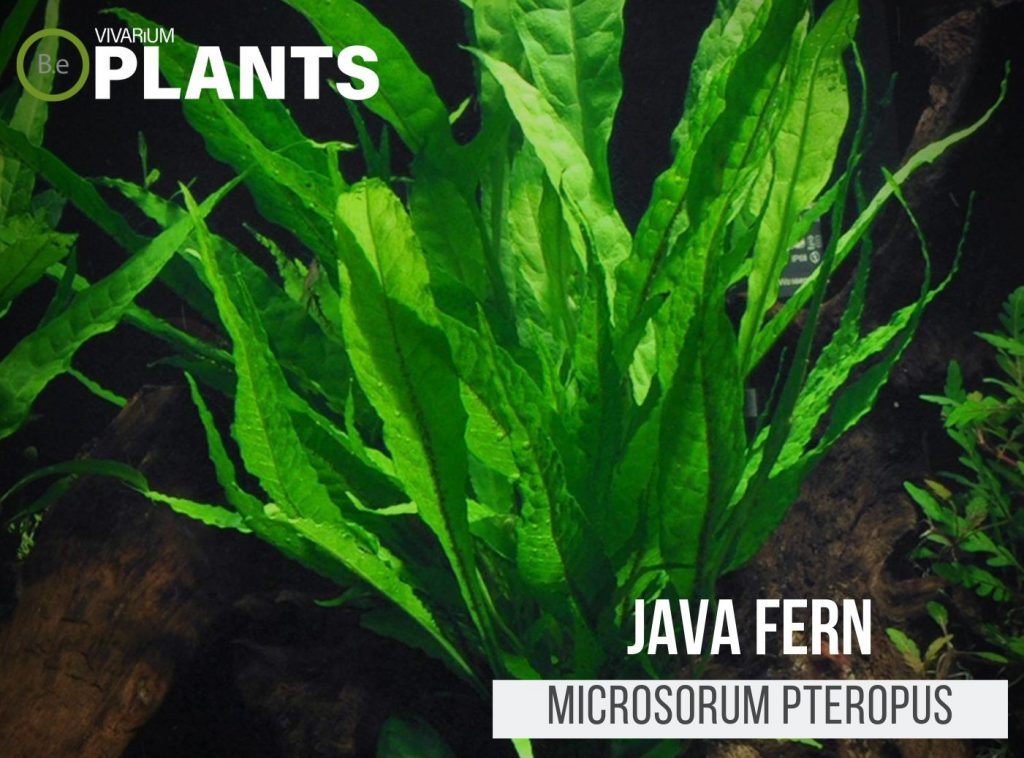

Microsorum pteropus’ leaves are very hardy and have a leathery texture.
Since there are different varieties of this fern, the shape of its leaves varies depending on each type.
They will look anywhere from bushy to spiky and come in a variety of green colors.
As far as specific needs go, this polypodiophyta barely has any.
As long as it has enough water, some lighting, and is kept away from direct sunlight you will continue to see this fern grow.
Perhaps the main reason why it tends to be the first plant beginners experiment with.
Water Sprite Plant (Ceratopteris thalictroides)
Water Sprite Fern is another rather common plant hobbyists enjoy growing in their vivarium.
It is quite versatile and does not require an extensive amount of care.
Despite being an aquatic plant, it does not have to be fully submerged at all times.
It can flourish just as well when sticking out of the water or even used as a floating plant.
Unlike most other ferns, it has a very stringy look.
Really making it great for creating a diverse and tropical look inside a tank.
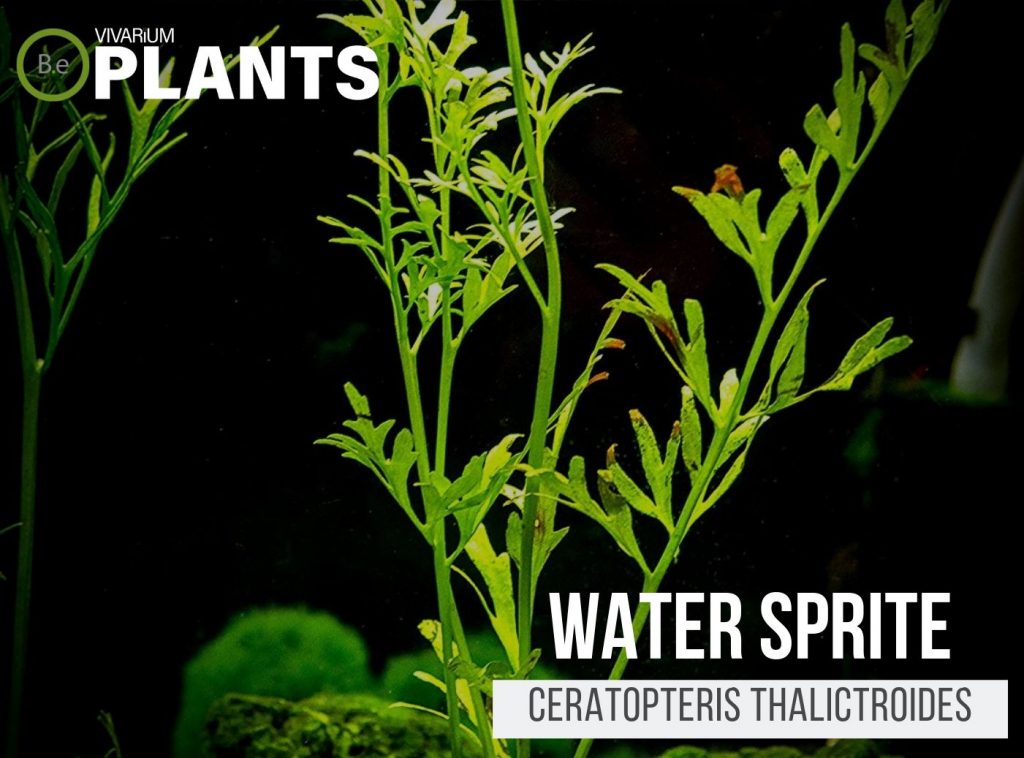

What makes this fern exceptionally desirable for most enclosures is its widespread distribution.
Ceratopteris thalictroides is native to pan-tropical regions in almost every continent.
This means that the plant will survive in pretty much all lighting and PH conditions.
Even though it is mainly a freshwater plant, you could even add it to an enclosure with brackish water. Check out this extensive guide about Ceratopteris thalictroides for care tips and more information about this type of plant.
African Water Fern (Bolbitis heudelotii)
Bolbitis heudelotii is an extremely popular freshwater fern for planted aquariums.
Although it is not as common as other species, it has come into high demand due to its distinct textured leaves and growth pattern.
African Water Fern has toothy-looking dark green leaves that may appear somewhat transparent.
They can grow anywhere from 15-40cm long and 15-25cm wide under the right conditions.
The fern itself is not much of a fast grower. Which makes it ideal for medium-sized enclosures.
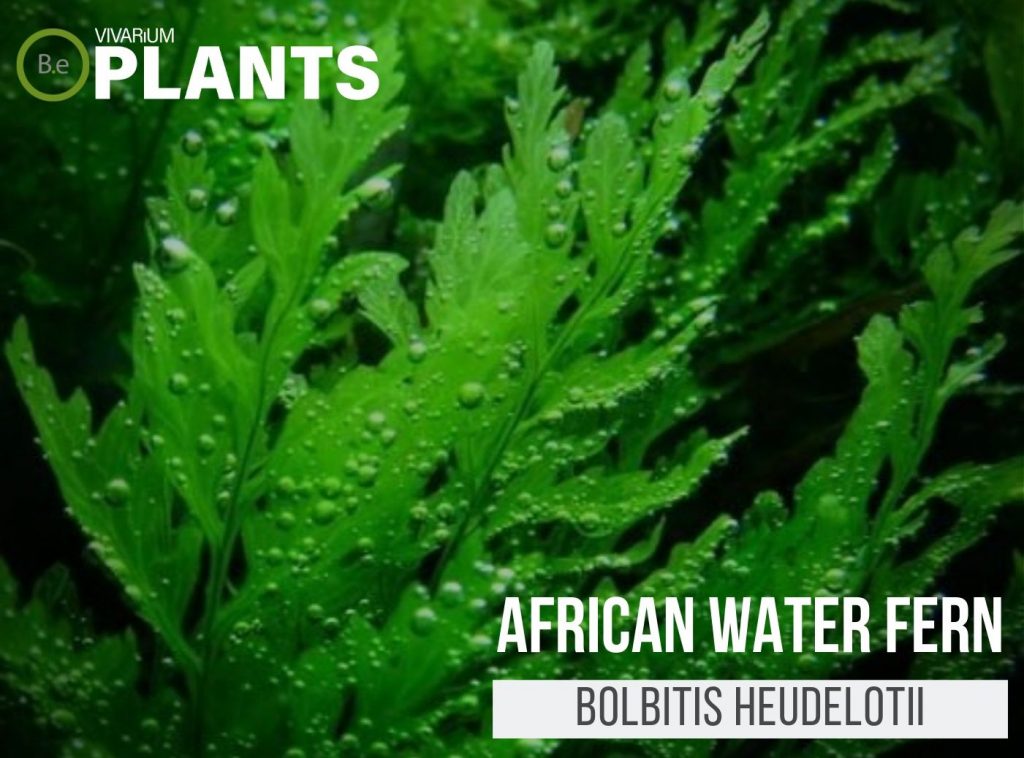

This plant does not require a drastic amount of caretaking once it has been established.
However, there are a couple of things that must be kept in mind to get it properly settled.
Low to moderate lighting will be best for optimal growth.
This fern requires moderately acidic to neutral water with a PH range of 6.0 to 8.5.
It does not tolerate hard water at all and will do best with a temperature range of 68 to 82.4 degrees Fahrenheit.
Steady water flow must also be provided in order for African Water Fern to remain healthy and thrive.
Broad-Leaf Water Sprite (Ceratopteris cornuta)
Broad-Leaf Water Sprite is an excellent addition to any hobbyist’s aquarium.
This beautiful aquatic fern is a popular choice for an aquascape due to its versatility and easy care requirement.
It is safe for any pets that could potentially consume it and is also fine with any other aquarium inhabitants.
While this plant doesn’t have any pronounced color, it contributes elegant texture throughout any aquascape.
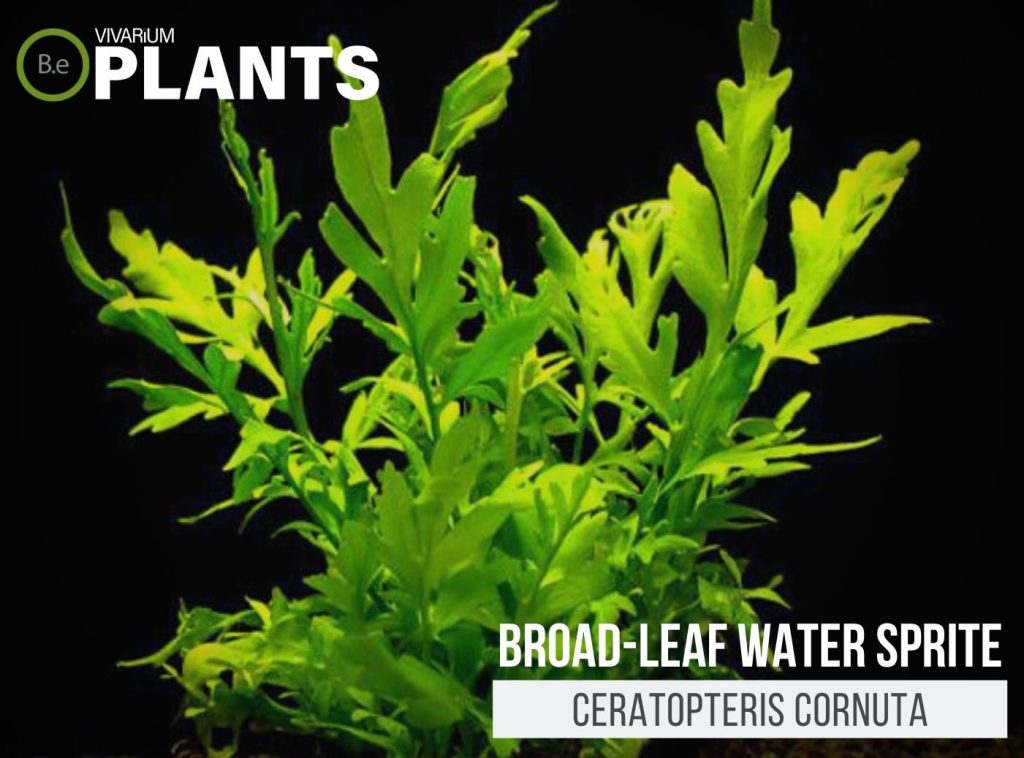

This plant will practically take care of itself under the right conditions. Moderate lighting will be best for thriving growth.
This fern requires neutral water with a PH range of 7.0.
It does not tolerate hard water at all and will do best with a temperature range of about 75 degrees Fahrenheit.
Steady water flow must also be provided in order for broad-leaf water sprite Fern to remain healthy and thrive.
In Summary
When browsing this list of possible polypodiophyta to stock your enclosure with…
Be conscious of the potential plant’s needs and the type of enclosure being built for it.
Understanding a few vital aspects of these vascular plants will make up the difference in having a successfully established tank.


If you are still having trouble trying to figure out which type of miniature fern would be best for your setup…
Feel free to drop a comment below and we will help you get the ball rolling.
Furthermore, If you would like to see a particular type of fern covered that is not yet on this list, let us know as well!
What is your experience with mini ferns…
Which types are your favorite types to have in an enclosure?
Frequently Asked Questions
Yes, mini ferns are a miniature type of fern that stay small and are perfect for indoor and outdoor containers. They are easy to care for and can stay at a height of 6 to 12 inches with an equal spread.
Caring for a miniature fern is simple. Start by placing it in indirect light or bright, indirect light. Water when the top layer of the soil starts to feel dry and be sure to water enough that the soil is completely moist. Use a balanced fertilizer every two weeks for the best results. Do not mist the fern or allow water to collect in the center of the plant. Finally, make sure to provide plenty of humidity for the fern.
1. Japanese Holly Fern (Cyrtomium falcatum)
2. Hart’s Tongue Fern (Phyllitis scolopendrium)
3. Bird’s Nest Fern (Asplenium nidus)
4. Deer Fern (Blechnum spicant)
5. Western Sword Fern (Polystichum munitum)
6. Button Fern (Pellaea rotundifolia)
7. Autumn Fern (Dryopteris erythrosora)
8. Spleenwort (Asplenium trichomanes)
9. Creeping Shield Fern (Dryopteris dilatata)
10. Silver Brake Fern (Pteris ensiformis)
Yes, dwarf ferns are a group of ferns that are generally slow–growing and grow to a smaller size than standard ferns. Many species of dwarf ferns include the maidenhair, asparagus, and Christmas ferns.
Water your mini fern when the top inch of soil begins to feel dry. Depending on your home‘s climate, you may need to water as often as once a week or only every other week. To check the soil, stick your finger in the soil and feel for dryness. If it‘s dry, water your mini fern until the soil is moist.
Yes. Ferns do like to be misted, as it helps to recreate the humid environment they thrive in. This can help to keep the leaves of the ferns from drying out and improve the overall health of the plants. However, be sure not to overwater them and mist them 3–4 times a week.
The best way to water a fern is to do so from the bottom. To do this, place the pot in a bowl or tray filled with water, wait 15 minutes, and then pour off any excess water that has been collected in the tray. This ensures that the soil of the fern is thoroughly watered without causing any root rot.
Yes! Epsom salt can help ferns grow by providing essential elements and minerals, such as magnesium sulfate. Adding Epsom salt to soil helps boost magnesium and sulfur levels, while also helping to strengthen cell walls, stimulate root growth, and increase seed germination.
